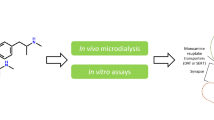Abstract
Phenylpiperazines, such as meta-chlorophenylpiperazine (MCPP) a serotonin agonist, have recently been reported to block conditioned avoidance responding (CAR) in the rat, which is an indication of possible antipsychotic utility. Since MCPP is a major metabolite of both antidepressant drugs trazodone (TZ) and etoperidone (ET), both were examined for activity in blocking CAR in a single-trial lever press task in Fisher 344 rats. Both TZ and ET produced dose-related falls in CAR with ED50 values (95% confidence limits) of 13.3 (9.6, 18.5) and 10.4 (8.5, 13.2) mg/kg IP, respectively. In contrast, MCPP had an ED50 value of 2.5 (1.8, 3.6) mg/kg IP TZ, ET, and MCPP were also examined for the production of catalepsy and the blockade of amphetamine-induced stereotypy to determine whether each was acting to block CAR via a dopaminergic mechanism of action. None, however, was found highly active. On the other hand, the serotonin receptor blocker metergoline (1.0 mg/kg IP) significantly reduced the CAR block produced by each, suggesting a serotonergic mechanism of action. Since TZ and ET are both less potent than MCPP, the data also suggest TZ and ET may block CAR via formation of MCPP.
Similar content being viewed by others
References
Arnt J (1982) Pharmacological specificity of conditioned avoidance response inhibition in rats: inhibition by neuroleptics and correlation to dopamine receptor blockade. Acta Pharmacol Toxicol 51:321–329
Boissier JR, Portmann-Cristesco E, Soubrie P, Fichelle J (1974) Pharmacological and biochemical features of trazodone. In: Ban TA, Silvestrini B (eds) Trazodone, modern problems of pharmacopsychiatry, vol 9. Karger Basel, pp 18–28
Brodgen RN, Heel RC, Speight TM, Avery GS (1981) Trazodone: a review of its pharmacological properties and therapeutic use in depression and anxiety. Drugs 21:401–429
Caccia S, Ballabio M, Samanin R, Zanini MG, Garattini S (1981) (-)-m-Chlorophenylpiperazine, a central 5-hydroxytryptamine agonist, is a metabolite of trazodone. J Pharm Pharmacol 33:477–478
Casacchia M, Meco G, Cusimano G, Boni B, Argenta G, Calvani M (1981) Is etoperidone a neuroleptic drug? An open study in schizophrenic patients. Lav Neuropsichiat 68:1–11
Creese I, Iversen SD (1974) The role of forebrain dopamine systems in amphetamine induced stereotyped behavior in the rat. Psychopharmacology 39:345–357
Fong MH, Garattini S, Caccia C (1982) 1-m-Chlorophenylpiperazine is an active metabolite common to the psychotropic drugs trazodone, etoperidone and mepiprazole. J Pharm Pharmacol 34:674–675
Georgotas A, Forsell TL, Mann JJ, Kim M, Gershon S (1982) Trazodone hydrochloride: a wide spectrum antidepressant with a unique pharmacological profile. Pharmacotherapy 2:255–265
Hennies HH, Friderichs E (1984) Influence of etoperidone andm-chlorophenylpiperazine on neurotransmitter systems. Paper presented at IUPHAR 9th International Congress, London
Kern U, Richter W (1985) Clinical comparison of etoperidone and amitryptyline in endogenous depressive patients. Pharmacopsychiatry 18:94–95
Kuribara H, Tadokoro S (1981) Correlation between antiavoidance activities of antipsychotic drugs in rats and daily clinical doses. Pharmacol Biochem Behav 14:181–192
Lisciani R, Baldini A, DeFeo G, Silvestrini B (1978) Pharmacological investigations on etoperidone, a new psychotropic agent. Arzneimittelforschung 28:417–423
Maj J, Palider W, Rawlow A (1979) Trazodone, a central serotonin antagonist and agonist. J Neural Transm 44:237–248
Martin GE, Elgin RJ (1988) Effects of cerebral depletion of norepinephrine on conditioned avoidance responding in Sprague-Dawley and Fisher rats. Pharmacol Biochem Behav 30:137–142
Martin GE, Elgin RJ, Kesslick JM, Baldy WJ, Mathiasen JR, Shank RP, Scott MK (1988) Block of conditioned avoidance responding in the rat by substituted phenylpiperazines. Eur J Pharmacol 156:223–229
Martin GE, Elgin RJ, Mathiasen JR, Davis CB, Kesslick JM, Baldy WJ, Shank RP, DiStefano DL, Fedde CL, Scott MK (1989) Activity of aromatic substituted phenyl piperazines lacking affinity for dopamine binding sites in a preclinical test of antipsychotic efficacy. J Med Chem 32:1052–1056
Moyer JA, Lucki I (1985) The piperazine serotonin (5-HT) agonistsm-chlorophenylpiperazine and 6-chloro-2-(1-piperazinyl) pyrazine (MK-212) impair avoidance responding in a discrete trial conditioned avoidance procedure. Proc Soc Neurosci 11:1186
Przegalinski E, Lewandowska A (1979) The effect of etoperidone, a new potential antidepressant drug, on the central serotonin system. J Neural Transm 46:303–312
Ramacci MT, Ghirardi C, Maccari F, Pacifici L, Sale P (1979) Pharmacological evaluation ofΔ 2, 1,2,4-triazolin-5-one [1,3(4-m-chlorophenyl-1-piperazyinyl)-propyl]-3,4-diethyl-hydrochloride (etoperidone), a new potential antidepressant drug. Arzneimittelforschung 29:294–307
Sansone M, Melzacka M, Ammasari-Teule M, Renzi P, Vetulani J (1985a) The effect of chronic administration of trazodone on the acquisition of avoidance behavior in mice. Pol J Pharmacol Pharm 37:173–178
Sansone M, Melzacka M, Vetulani J (1985b) The role of trazodone metabolism in this inhibitory action on avoidance response. Pharmacol Biochem Behav 23:137–140
Seeman P (1980) Brain dopamine receptors. Pharmacol Rev 32:229–313
Silvestrini B, Cioli V, Burberi S, Catanese B (1968) Pharmacological properties of AF 1161, a new psychotropic drug. Int J Neuropharmacol 7:587–599
Stefanini E, Fabio F, Lucio M, Gessa GL (1976) Selective inhibition of serotonin uptake by trazodone, a new antidepressant agent. Life Sci 18:1459–1466
Valeri P, Angelucci L (1977) Inhibition of monoamine uptake in brain by etoperidone, 18th National Congr Ital Soc of Pharmacology. 1st USSR-Italian Joint Meeting, Modena, Italy 1976. Abstracts 137
Author information
Authors and Affiliations
Rights and permissions
About this article
Cite this article
Martin, G.E., Mathiasen, J.R. & Kesslick, J.M. Blockade of conditioned avoidance responding by trazodone, etoperidone, and MCPP. Psychopharmacology 99, 94–97 (1989). https://doi.org/10.1007/BF00634460
Received:
Accepted:
Issue Date:
DOI: https://doi.org/10.1007/BF00634460




